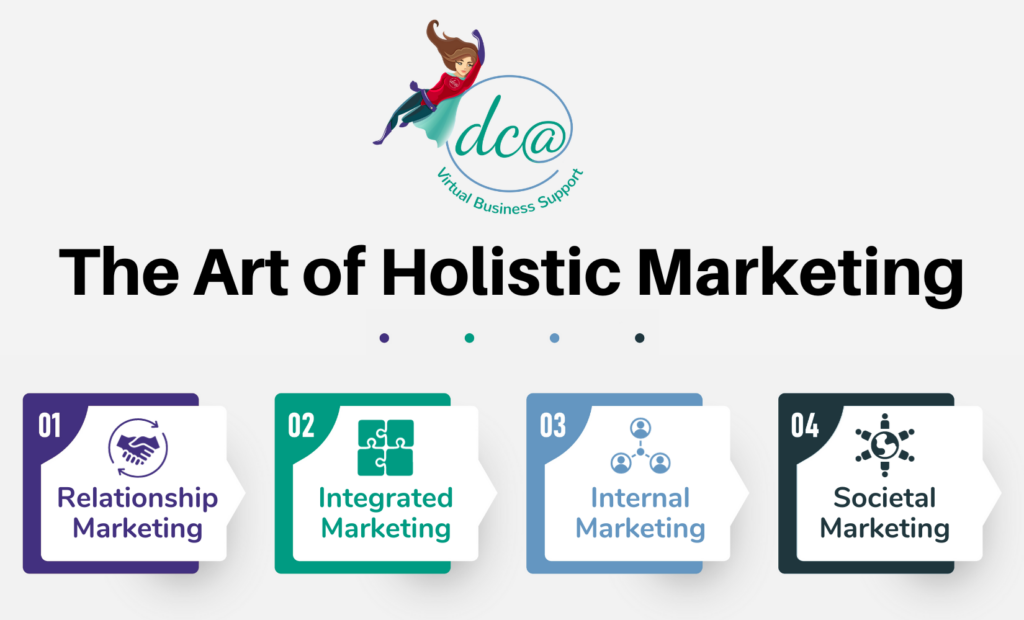
The Art of Holistic Marketing
In the ever-evolving world of marketing, businesses are constantly seeking innovative strategies to connect with their audience and drive meaningful engagement. A holistic approach to marketing is a powerful solution, incorporating various channels and platforms to create a seamless and integrated customer experience. In this blog, we’ll explore what a holistic marketing approach is, identify its key components, and provide suggestions for how you can capitalize on your marketing efforts through a holistic approach.
What is a Holistic Approach to Marketing?
A holistic approach to marketing considers all aspects of your business. It means crafting strategies that address the different parts of marketing, from social media management to customer service. The goal is to create a cohesive and integrated experience for customers across various channels, providing a consistent experience and nurturing a deeper connection with your audience. For our visualizers, think of the holistic approach to marketing like a map with many different signs but all pointing to the same road.
The 4 Pillars of Holistic Marketing
Relationship Marketing
Relationships are built through interactions, so it is vital that your customers have good interactions with your business, so they stick around. And relationship marketing is all about just that, forming long-terms relationships. You can nurture these types of relationships with customers by getting to know them beyond the standard transaction – what are their likes and dislikes, what do they need, what are their habits, etc. Personalize their experience, focusing on customer satisfaction. A happy customer can lead to free advertising and contribute to increased sales and loyalty. According to a recent study, 81% of consumers are “likely” or “highly likely” to leave a positive review if they feel the business went above and beyond to ensure an exceptional experience.
Integrated Marketing
Integrated marketing aims to deliver a consistent message to customers across all marketing channels. This includes drawing consistent messaging and wording, communication strategies, and branding. A customer should be able to look at your Instagram page and draw the same conclusion that they would from your website or an advertisement they see on TV. There are multiple avenues to deliver but the message should remain the same. If there are multiple messages and concepts, then people get confused and might draw the wrong conclusion about your brand and what you do.

Internal Marketing
Holistic marketing thinks both inside and outside of the box, not only focusing on your external audience, but on your internal audience too. Stakeholders, such as employees and partners, are just as important in your marketing plan as someone who learns of your brand through a random Google search. Internal marketing ensures that everyone within the organization is aligned with your brand values and understands their role in delivering a consistent brand message. Engaged and motivated employees become ambassadors for the brand, influencing both customer experiences and outside perceptions. Internal marketing is also a steppingstone to hiring the right people for your organization. Understanding your brand internally defines the roles and characteristics of the players on your team.
Societal Marketing
Societal marketing recognizes the broader impact of the business’s actions on the community. It focuses on the ethical, social, and environmental impacts of marketing strategies, aiming to meet customer needs while positively contributing to the well-being of society and the environment.
An example of societal marketing is the following statement from Founder & CEO of Askinosie Chocolate:
“As business owners, our greatest opportunity and challenge has been weaving social responsibility into everything we do; it’s not just a buzzword, it’s who we are. Askinosie Chocolate was born committed to fairness, sustainability, minimal environmental impact, and community enhancement. Those commitments will be in place as long as the company is. We’re dedicated not just to making the best quality chocolate you can buy, but to making it in such a way that the more you learn about it, the better you feel about it. And we’re so glad you’re here.”
Conclusion
In the holistic approach to marketing, every element is vital to shaping your customer’s journey with your business and brand. By considering the four pillars of the holistic marketing approach, you can up your company’s visibility and value to consumers.
If you enjoyed this blog, stay tuned for part two of The Art of Holistic Marketing: Utilizing the Tools in the Shed where we discuss how to leverage drip campaigns, reengagement campaigns, and scheduling applications!
At DCA Virtual Business Support, we can help you unlock your brand’s full potential in the digital landscape. Whether you are looking for assistance with email marketing, social media management, website creation, or performing a user audit, our team can do it all. Visit our website to learn more about our services.
